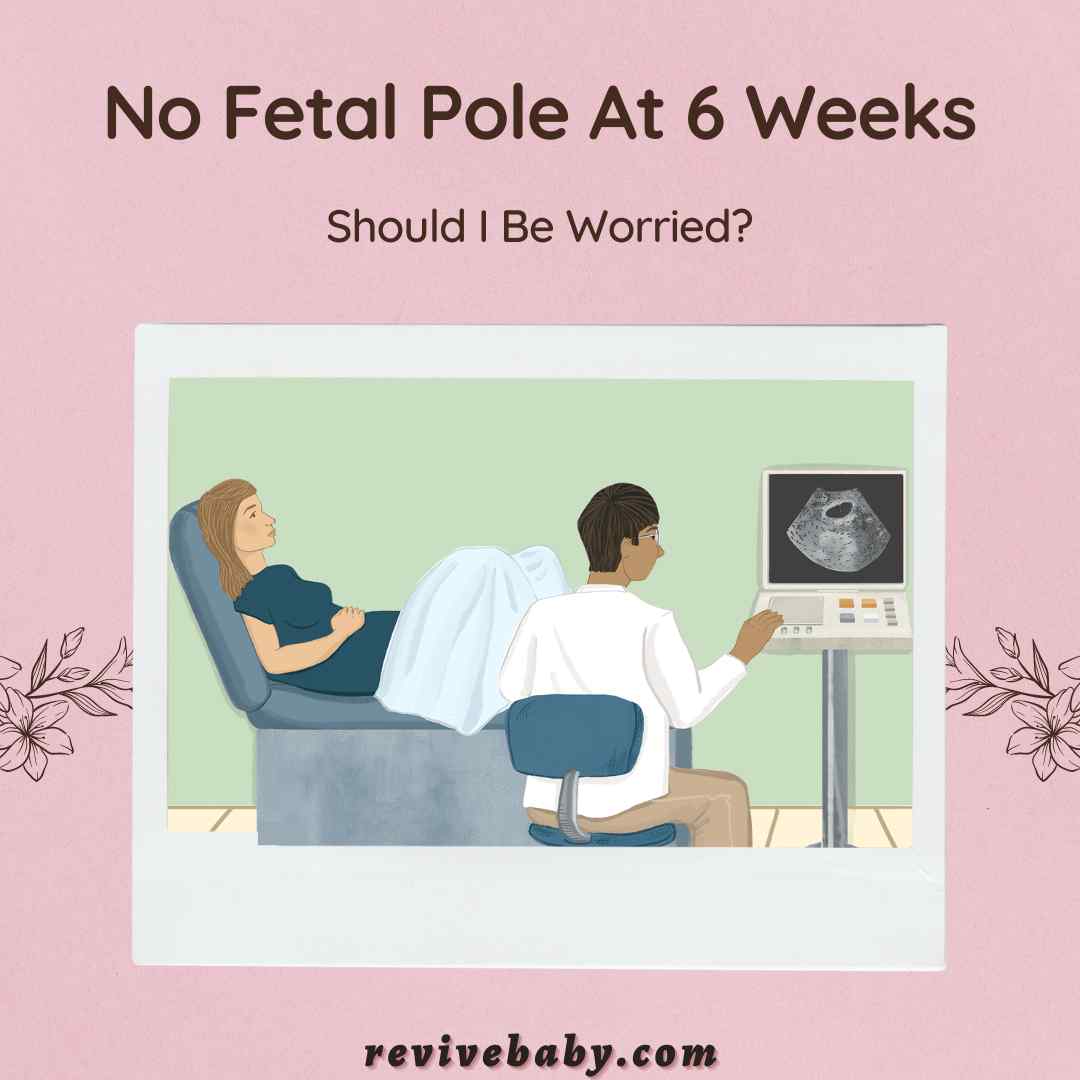After six weeks, you go for an ultrasound, but you cannot see the fetal pole and wonder if having no fetal pole at six weeks is a sign of normal pregnancy.
If that is the case, then keep on reading because here we will talk about all the essential information you must have about the fetal pole.
What Exactly Is A Fetal Pole At Six Weeks?
Many new mothers don't even know what a fetal pole is, why it is a sign of normal pregnancy, and what to expect after 5 to 6 weeks. If you are also a first-time mother and want to know the role of the fetal pole, then here is all the information you need.
What Is A Fetal Pole?
It is one of the early stages of the growing baby, and if the pregnancy is healthy, then a fetal pole is converted into a fetus. During the ultrasound, it is visible between 5 to 6 weeks and is also called an embryo or embryonic pole.
Why Is The Fetal Pole Not Visible At Six Weeks?
In most cases, your gynecologist will be able to see your fetal pool, but there are some cases in which the fetal pole is not visible even at 6 to 7 weeks after pregnancy so let's take a look at those reasons.
It's Too Early
One of the main physiological reasons your gynecologist will be unable to see the fetal pole after 5th week is that it's too early. Most of the time, pregnancy is confirmed by the body's HCG level and the date of the last period. The amount of HCG in your body can only indicate that you are pregnant and can't tell the duration of pregnancy.
Duration of pregnancy is only calculated with the help of the last missing period until the baby starts developing organs, so if you are not correctly remembering your last period, it will be hard for the gynecologist to see the fetal pole.
Irregular Cycle
Another physiological reason why the fetal pole is not visible at six weeks is an irregular cycle. It is assumed that an ovulation cycle lasts for 28 to 30 days, but it is not true. It may fluctuate a lot and can vary between 20 to 40 days.
You may ovulate early or later than the 14th day of the cycle. In case of early or late ovulation, your gynecologist will also be unable to see the fetal pole.
Blighted Ovum
It is also known as anembryonic pregnancy, and in this case, the gestational sac and placenta continue to grow, but they are empty. It mostly happens in the first trimester of pregnancy when the blastocyte implant In the Wall of the uterus.
It is one of the most common reasons for miscarriage in the first trimester of pregnancy. The placenta continues to release hormones, and the pregnant lady's body considers it a normal pregnancy.
It mostly happens around 7 to 9 weeks of pregnancy, and it is not diagnosed during the 6th week, so the gynecologist may think that you are messing up the dates of the last period.
Miscarriage
It is the second most common pathological reason, and multiple causes exist. Miscarriage is considered the loss of a baby before 20 weeks; most of the time, these are common in the first trimester of pregnancy.
There are many kinds of miscarriages, including missed, complete, recurrent, and inevitable miscarriages. According to research, almost 50% of miscarriages are because of chromosomal abnormalities, and others are because of physiological factors, including exposure to radiation, hormonal imbalance, or lifestyle.
Fetal Pole With No Heartbeat
It is not always necessary that your gynecologist doesn't see a fetal pole at six weeks. Sometimes the fetal pole is visible with the help of transvaginal ultrasound, and still, you undergo a miscarriage.
It is known as a silent miscarriage, and in this case, the embryo fails to develop, but the body has not yet been discarded, and the ultrasound shows the embryo.
If the fetal pole measures more than 7 millimeters and there is still no heartbeat, then the baby is not growing, and it will be a miscarriage.
Why Is The Fatel Pole Important?
Many people who don't have a deep knowledge of Medical sciences confuse the fetal pole with the placenta, and some people may think that the fetal pole is unnecessary.
The fetal Pole is not a part of a developing baby, but it's the baby itself, so it's extremely important to have a healthy fetal pole. Some of the main reasons which make the fetal pole extremely important are
If you are expecting more than one baby, then the number of the fetal pole will tell you how many multiples you have.
- When the baby had not started developing organs, then the size of the fetal pole determined the baby's age. It is helpful if you are unsure about your last period or if your periods were irregular before pregnancy.
- There are two types of pregnancies: viable ones and nonviable ones. The location of the fetal pole also helps in determining if your pregnancy is normal or not.
- This site and the shape of the fetal pole also help determine any pregnancy complications and may save the baby from miscarriage.
Care For Fetal Pole
In 50%of cases, if the miscarriage is not genetic, it can be prevented by taking proper care of the fetal pole. You can't prevent problems like ectopic pregnancy or genetic problems, but you can do a few things that may help prevent any miscarriage because of your negligence.
- Avoid any food which may contain Mercury, and it includes eggs, meat, and seafood. Also, avoid a dental visit during the first trimester because there is a risk of mercury exposure.
- Before taking any prescription or over-the-counter drug, talk with your gynecologist.
- Do light exercises, eat well and drink plenty of water.
- Try to provide alcohol and any tobacco-containing product.
- Take your medications regularly and consult a gynecologist in case of any change in your body.
If your pregnancy is normal, but in the third trimester, you face different issues because of the baby's movement, then you may want to go through why babies kick in the womb after eating.

What Does the Absence of the Fetal Pole Mean at Six Weeks?
If the fetal pole is not seen at the expected time, the ultrasound may have to be repeated in a few days.
A missing fetal pole is linked to several problems and illnesses.
- When a fertilized egg implants in the uterine lining but fails to develop into an embryo, this is referred to as a blighted ovum or anembryonic pregnancy. As a consequence, the pregnancy will end prematurely.
- You may not be able to see the embryo if the pregnancy isn't far enough along. In addition, if your menstrual cycles have been erratic, your estimated gestational age may be wrong.
- Miscarriage is suspected when an ultrasound fails to show a fetal pole and a gestational sac.
When the fetal pole is found outside the uterus, it is called an ectopic pregnancy. This is a dangerous pregnancy that should be handled as a medical emergency. A gestational sac is also conceivable in the following cases:
- Abdomen.
- Cervix.
- Anatomy of the Fallopian Tube (most common).
- Ovary.
No Heartbeat In Fetal Pole At Six Weeks
Despite the existence of a fetal pole as indicated by transvaginal ultrasound, the healthcare provider may find that the baby’s heart is not beating. A miscarriage occurs when the crown-rump length of an unviable fetal pole surpasses 7 millimeters.
A missed miscarriage happens when the embryo dies or fails to develop, but the body does not miscarry. Instead, the ultrasound indicates an amniotic sac containing an embryo but no heartbeat.
Even if you have little warning signals, the pregnancy is doomed if there is no heartbeat. Your doctor will tell you if a miscarriage is missed.
FAQs
What is the normal location of a fetal pole?
The fetal pole is located near the Yolk sac And gets nutrients from the Yolk sac. The fetal pole and the yolk sac are located inside the gestational sac, and the gestational sac is in the uterus.
What is visible first, a heartbeat or a fetal pole?
Most of the time, the fetal pole and the heartbeat can be observed simultaneously, but in very few cases, The fetal pole may become visible first, and then after just a day or two, you will feel the heartbeat.
Conclusion
The fetal pole distinguishes the embryonic stage of pregnancy. A fetal pole gives birth to a fetus, which matures into a newborn baby if the pregnancy goes correctly. You should discuss pregnancy ultrasound results with your healthcare physician.
Mood changes are extremely frequent throughout pregnancy. A positive pregnancy test is a cause for celebration, but waiting for two to confirm the pregnancy is crucial. Conversely, encountering hurdles along the path might be stressful and unpleasant.
Even when they want to, loved ones don't always know what to say or do to express their feelings. If you are having difficulties dealing with pregnancy or fertility-related challenges, you should discuss your concerns with a healthcare practitioner or a mental health specialist.









